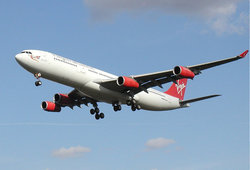Wide-body aircraft
|
|
A wide-body aircraft is a large airliner with a fuselage diameter of about 5 to 6 metres and twin aisles. Passengers are usually seated 7 to 10 abreast. For comparison, a traditional narrow-body airliner has a diameter of 3 to 4 metres, a single aisle, and seats arranged 4 to 6 abreast. Typical wide-body aircraft can accommodate between 200 and 600 passengers, where the largest narrow-bodies carry about 280. Freight-only versions exist as well, which are similar bar the cargo-loading arrangements.
The first wide-body aircraft was the four-engined Boeing 747 which debuted in 1969 and currently the largest in passenger service, however the Airbus A380 will be larger, when it enters service in 2006. Slightly smaller and shorter ranged three-engined wide-bodies followed in the early 1970s—the McDonnell Douglas DC-10 and the Lockheed L-1011 Tristar—then the twin-engined Airbus A300 in 1974. Subsequent commercial wide-bodies include the Ilyushin Il-86 (1980), the Airbus A310 (a shortened A300) and Boeing 767 (1982), the McDonnell Douglas MD-11 (1986), the Ilyushin Il-96 (1992), the Airbus A330/A340 family (1993), and the Boeing 777 (1995). The United States and the Soviet Union both produced dedicated military wide-body transports: the Lockheed C-5 Galaxy and C-141 Starlifter, the Ilyushin Il-76 "Candid", the Antonov An-124/An-225, and the Boeing C-17 Globemaster III.
Design considerations
Although a wide-body aircraft has a larger frontal area than a narrow-body of equivalent capacity, and thus greater form drag, it has several advantages:
- Lower ratio of surface area to vol, and thus (for equal volume) lower frictional drag.
- Shorter twin aisles make loading and unloading faster and reduce the difficulty of serving refreshments.
- Shorter overall length, which makes it easier to achieve the desired take-off rotation angle without very long and heavy landing gear.
- Greater under-floor freight capacity.
- Simple size: it is possible to make a wide-body aircraft much larger than a narrow-body and, all else being equal, the larger the aircraft the lower the fuel-burn per passenger-mile and the lower the cost.
Operating considerations
When traveling in civil airspace (particularly in North America and Europe), operators will often suffix their call sign with the word "Heavy". An example would be the call sign "United Flight 342 Heavy", for a Boeing 777. This is because wide-body aircraft (and one non-wide-body aircraft, the Boeing 757) tend to leave wake vortices as they travel, making the area immediately behind unsafe for smaller aircraft. The amount of separation between aircraft is a judgement call based upon the size and turbulence of the leading aircraft.de:Gro▀raumflugzeug id:Pesawat badan-lebar

